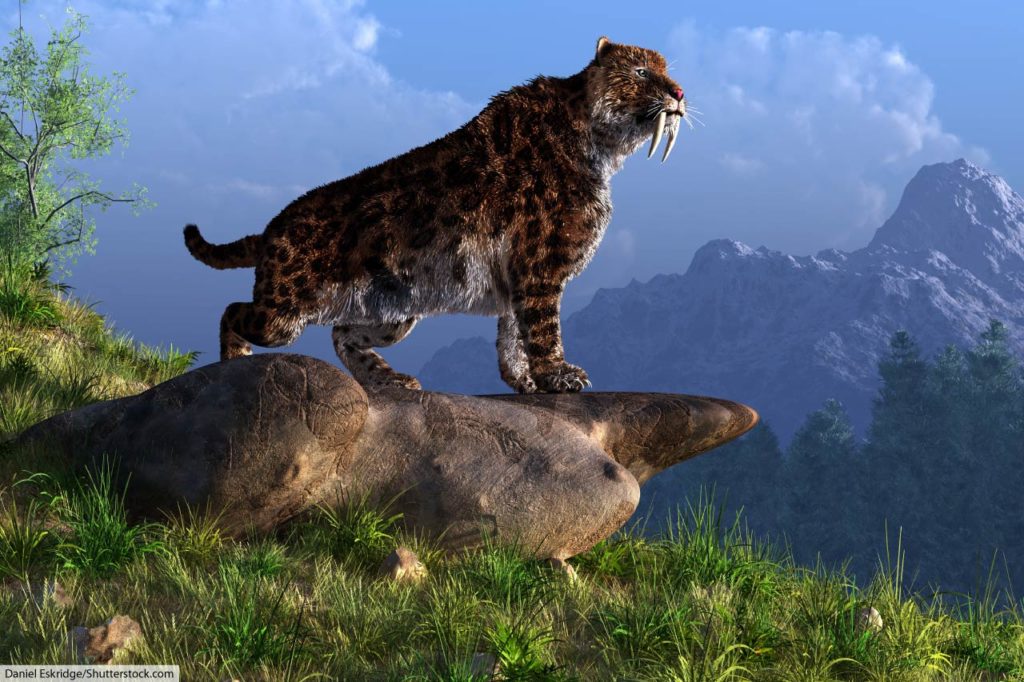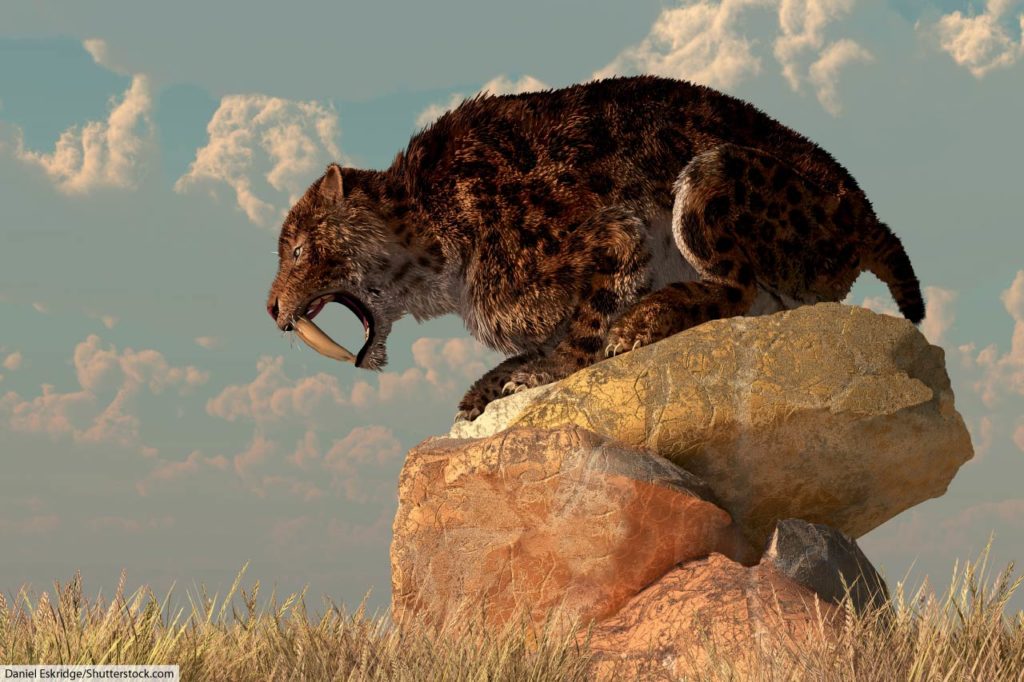Smilodon facts for kids and adults. On this page you’ll find pictures and information on one of the world’s best-known prehistoric animals: the 'saber-toothed' cat Smilodon.
Smilodon Facts At A Glance
- Other Name(s): Sabre-toothed cat, saber-toothed tiger, saber-toothed lion
- Scientific name: Smilodon
- Type of Animal: Mammal, member of the order Carnivora
- Animal Family: Felidae
- Fossils Found: North America, South America
- Time Period: Pleistocene epoch, early Holocene epoch (2.5 Mya to 10,000 years ago)
- Estimated Weight:
- S. gracilis: 55 to 100 kg (120 to 220 lb.)
- S. fatalis: 160 to 280 kg (350 to 620 lb.)
- S. populator: 220 to 400 kg (490 to 880 lb.)
- Conservation Status: Extinct
Meet Smilodon: Introduction
Smilodon is an extinct member of the cat family, Felidae. It lived in the Americas from 2.5 Mya (million years ago) to 10,000 years ago, during the Pleistocene and early Holocene.
Smilodon was around the size of today’s big cats. Its most distinctive characteristic was a pair of fearsome oversize canine teeth that projected downwards from the upper jaw.
Rather than being a single species, Smilodon is a genus - a small group of closely-related animals. In fact there are three known Smilodon species: Smilodon gracilis, Smilodon fatalis and Smilodon populator. Smilodon populator was the largest smilodon and is among the largest cats ever to have lived.
Smilodon is the best-known of around 12 genera whose members are known as 'saber-toothed cats'.
The name of the genus (i.e. the 'Smilodon' bit of the two-part scientific name) means ‘knife tooth’.
What Did Smilodon Look Like?
Smilodon was a heavily built, muscular cat with powerful forelimbs and a short tail.
The 3 species differed greatly in size: S. populator was the largest and its estimated weight was up to 4 times that of S. gracilis. S. gracilis was roughly the size of the modern jaguar, while S. fatalis was similar in size to a modern lion.
The blade-like canines of Smilodon were long and slender with finely serrated edges. These deadly weapons were up to 28 cm (11 in) in (curved) length.
Smilodon has been depicted with both a plain and a spotted coat. However, these are artistic impressions; the actual pattern and coloration is unknown.
There appears to have been little to no difference between males and female smilodons.
Where Was Smilodon Found?
Two of the three known Smilodon species (S. gracilis and S. fatalis) were primarily found in North America, while S. populator was restricted to South America.
It is thought that S. populator may have evolved from S. gracilis after the latter species spread to South America during the early to middle Pleistocene.
In the late Pleistocene, S. fatalis also entered South America, remaining mainly west of the Andes mountain range.
The largest number of Smilodon fossils (S. fatalis) have been found in the La Brea Tar Pits in Los Angeles, California.
Smilodon Habitat
Most Smilodon fossils have been found in sediment layers from woodland environments and plains. As a probable ambush predator, Smilodon is likely to have inhabited forests, margins of woodlands and brushy plains. These areas would have offered cover as well as access to large prey animals.
Smilodon Behavior
It is unclear whether Smilodon was solitary or social – the fossil remains of the animal have been interpreted to support both views.
Communication
The size and the flexibility of the hyoid bone (tongue-bone) suggests that Smilodon, like modern lions, could have communicated by roaring. This would have made Smilodon a member of the group of animals known as ‘big cats’.
- See this article for more information: What is a Big Cat?
Movement
It is likely that Smilodon spent most of its life on the ground rather than in trees. The relatively small size and position of the Smilodon’s eyes means it wasn’t as good at perceiving depth as the modern arboreal (tree-dwelling) cat species. Its heavy build would also have made climbing difficult.
Smilodon likely relied on stealth rather than speed as a predator. Its limbs had similar proportions to those of modern forest-dwelling cats that rely on ambush hunting. Furthermore, Smilodon’s short tail would not have offered much assistance in balancing the cat while it was running fast.
Smilodon’s long heel bones suggest that it was good at leaping.
Smildon Life Cycle
The lack of a large size difference between the sexes suggests that the males did not compete aggressively for females, and that Smilodon may have been monogamous (mated with just one partner).
According to studies, Smilodon was physically robust from birth. The lack of juvenile fossils at La Brea Tar Pits suggests that the young probably remained in a den while their parents hunted.
The young developed their saber-teeth gradually: they first appeared at around the age of 1.5 years and reached their full size when the Smilodon was roughly 3 years old. For a period of several months, the young had both infant and adult canines in their mouth.
What Did Smilodon Eat?
Smilodon was a top predator and probably specialized in hunting large mammals.
In North America it hunted animals such as bison, camels, giant ground sloths and horses. In Florida, S. gracilis also probably preyed upon peccaries of the genus Platygonus, the large-headed llama-like animals of the genus Hemiauchenia, and possibly even the armadillo-like glyptodonts.
The dire wolf (Canis dirus) and the American lion (Panthera leo atrox) probably competed with the Smilodon for prey in North America.
In South America, the available prey animals included ungulates such as litopterns and toxodonts. The differences in typical prey may partly explain the physical differences between the different Smilodon species.
How Did Smilodon Hunt?
It is likely that Smilodon was probably an ambush predator that used its powerful forelimbs to grasp and pin down large prey.
How exactly Smilodon used its large canines is not clear: according to a popular theory, it may have delivered a fast, stabbing bite to the neck (as opposed to the slow, suffocating bite that modern cat species tend to use).
However, studies have shown that a dagger-like bite would have caused Smilodon’s teeth to shatter had they come into contact with bone. This may not have been a problem if, like modern cats, Smilodon was able to ‘feel’ with its teeth.
Another explanation is that the saber teeth were used to slice, rather than puncture, flesh, with the teeth in the lower jaw supplying leverage.
How Did Smilodon Eat?
Looking at Smilodon’s skull, you may have wondered how it could actually eat without those huge canine teeth getting in the way. A team of filmmakers found that this may not have been a problem. They put fake Smilodon teeth on lions (a brave thing to do!) and found that the cats had no problem eating their food.
Smilodon may also have scavenged carcasses left by other predators, but due to its brittle teeth it would have avoided biting into bone.
Extinction
Smilodon became extinct around 10,000 years ago during what is called the Quaternary extinction event. The most recent North American specimen to be found (S. fatalis) was dated to 13,025 years ago, while the most recent South American specimen (S. populator) was dated to between 10, 935 and 11,209 years ago.
The extinction of the genus may have been linked to the decline and extinction of the large herbivores on which it preyed. Climate change and competition from other predators may also have contributed to the disappearance of Smilodon.










fun facts on sabertooth tiger. I need help to find facts.
Hi, you’re in the right place: Smilodon was also known as the saber-toothed tiger! 👍🏻
Regards,
The Active Wild Team
Also how many babies can the Smilodon produce?
Another good question!
We are unaware of any studies on Smilodon litter size.
Therefore, we can only assume that Smilodon gave birth to a similar number of young to the three largest living cats.
A tiger has 2 to 3 cubs; a lion 1 to 4; and a jaguar 1 to 2.
From this, we could guess that Smilodon might typically have given birth to 2 cubs.
We’d love to hear from any paleontologists who could provide a more scientific answer!
The Active Wild Team
Where did it live? I am doing a project about the Smilodon and I need to know where it lives. I know it lives in the Americas but where in the Americas?
Hi,
Great question! There are three species of Smilodon: Smilodon gracilis, Smilodon fatalis, and Smilodon populator.
Smilodon populator lived in South America, and has been found as far south as southern Chile.
Most Smilodon gracilis and Smilodon fatalis specimens have been found in North America, although specimens attributed to both species have also been found in South America.
The largest number of Smilodon fatalis specimens were found in the La Brea tar pits, in Los Angeles, California, USA. The species has also been found in Alberta, Canada.
We hope this helps!
The Active Wild Team
No, Smilodon did not use its fangs to inject venom. Relatively few animals have venom, and Smilodon was not one of them.
Does smilodon use its fangs to inject venom?
No; the fangs were used like swords or daggers (see the “How Did Smilodon Hunt?” section of the article).
There are only a handful of venomous mammals. Thankfully cats aren’t among them! 🙂
Regards,
The Active Wild Team